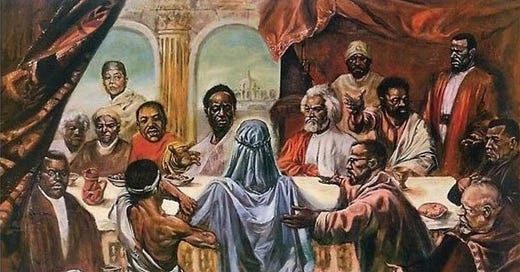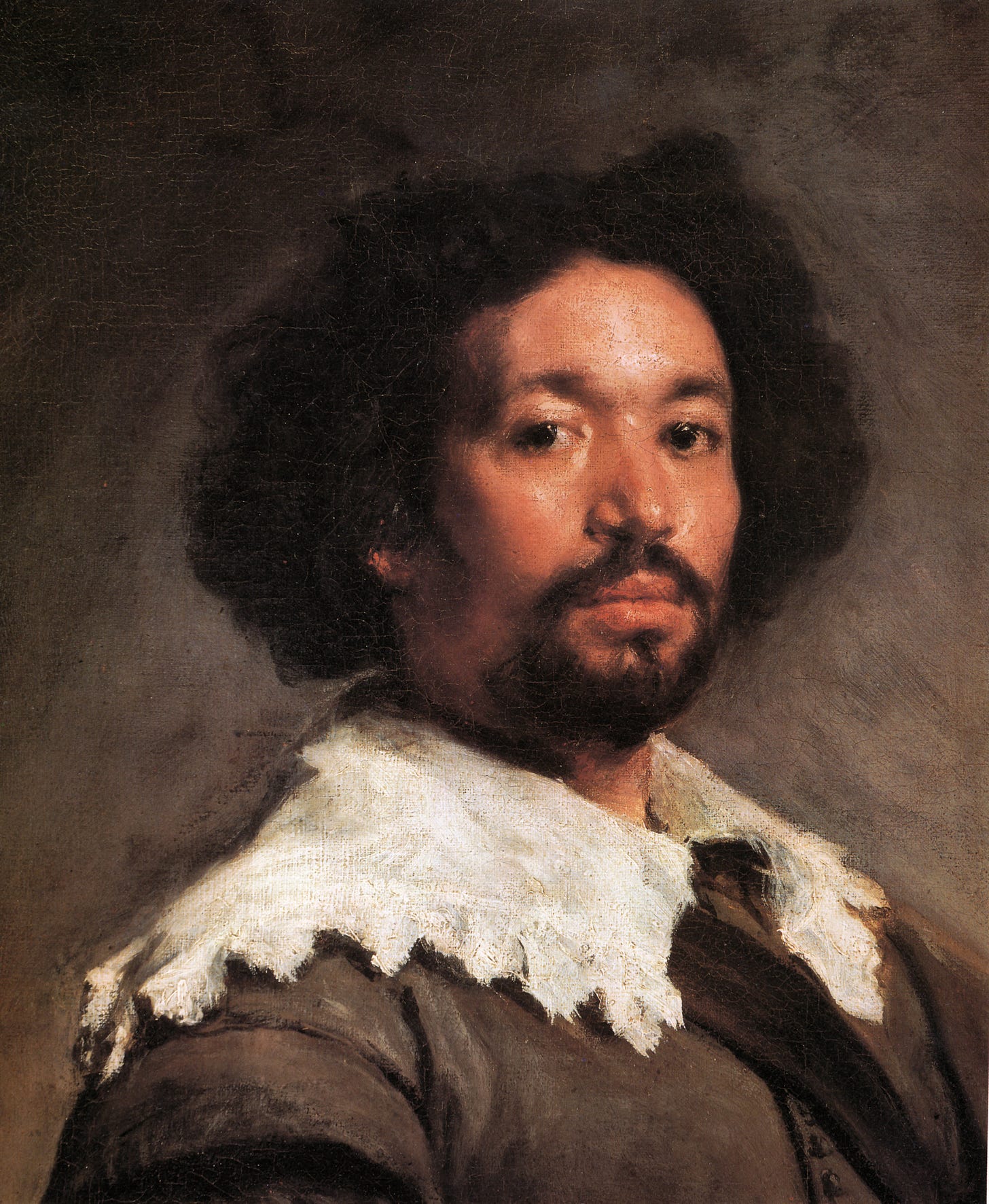Just Skimming | 4/9
A collage of my weekend news and information consumption. I hope you find it useful, informative, and even slightly entertaining
Easter and the indestructibility of hope
“Last Supper,” 1986, by Cornell Barnes. The historical Black figures depicted in the painting include Rev. Martin Luther King, Jr., Malcolm X, Frederick Douglass, W.E.B. DuBois, Marcus Mosiah Garvey, Mary McLeod Bethune, Harriet Tubman, Booker T. Washington, Paul Robeson, Nat Turner, Noble Drew Ali, Kwame Nkrumah, Elijah Muhammad, and Judas.
“[The] indestructibility of hope might be the central and most radical claim of Easter — that three days after Jesus was killed, he returned to his disciples physically and that made all the difference. Easter, then, is [not a] metaphor for new beginnings; it is about encountering the person who, despite every disappointment we experience with ourselves and with the world, gives us a reason to carry on.”
“So this Easter I will make my way with my family to the South Side of Chicago, to that congregation that serves as our church home. I will do my best to join in the songs of celebration, not because I no longer feel the darkness that has marked so much of my journey, but because sometimes I still do.”
— An opinion piece in the New York Times by Esau McCaulley, an associate professor of New Testament at Wheaton College and theologian in residence at Progressive Baptist Church in Chicago. McCaulley writes that he’s much more comfortable with Maundy Thursday, “the beginning of the Triduum, the Christian calendar's holiest three days and the one that remembers Jesus’ last meal with his disciples.
Scam U?
“I’m so regretful every day. I just keep paying but I’ll never be rid of it.”
— Amanda Luciano, 37, quoted in an article published in this weekend’s Daily Herald. In February, the 200,000 students across the country who took out federal student loans to go to for-profit colleges churning out worthless degrees learned that their loans were canceled. Luciano is not among them because she took out loans from a private lender, Navient. She borrowed $51,000 to attend the now-closed International Academy of Design and Technology, and over 15 years has paid back $41,000, “but because of the [9%] interest, her balance today stands at $81,000. Her current monthly payments of $500 cover only the interest, she says.” Luciano eventually took out federal student loans and enrolled at College of DuPage to become a certified preschool teacher — a much different career pathway than the one IADT promised her in design and merchandising.
— —
“Community colleges are far cheaper than four-year schools [...] Yet consumers are abandoning them in droves. The number of students at community colleges has fallen 37% since 2010, or by nearly 2.6 million, according to the National Student Clearinghouse Research Center.”
— Another article in this weekend’s Daily Herald focuses on the plummeting enrollment rates at community colleges in the U.S. “With scant advertising, many community college students spend time and money on courses that won’t transfer or that they don’t need.” Nearly half of community college students drop out within a year, failing to earn any credentials, and even if they do get credentialed, “many employers don’t believe they’re ready for the workforce.” This is also a racial inequity crisis since “half of all Hispanic and 40% of all Black students in higher education are enrolled at community colleges, according to the American Association of Community Colleges.”
Visually speaking
Screenshot of a chart accompanying an April 4 Bloomberg article on the “rising tide of global layoffs beyond tech.” Hat tip to Adam Tooze’s Chartbook, another Substack newsletter I highly recommend.
“While the US economy has so far remained strong, adding 311,000 jobs in February after adding more than half a million jobs in January, central banks’ increasingly aggressive campaign of rate hikes may expose more vulnerabilities in banks with interest-rate risk, like SVB, and startups that rely heavily on venture capital funding to maintain operations and payrolls.
“The rush of layoffs that began late last year isn’t letting up, marking the worst start to a year since 2009, with 52,000 jobs lost in one week in January alone. Since Oct. 1, executives across sectors have sacked almost 538,000 employees around the world, according to a comprehensive review of layoffs by Bloomberg News.”
The week in absurdity
“The protest and subsequent expulsion over decorum rules took place in a chamber where a GOP member, for years, rang a cowbell every day of session as a raucous, attention-grabbing substitute for applause.
“When I covered the Tennessee Capitol from 2018 to 2021, the family-values espousing Republican House speaker had to explain why his text message trail included discussions of pole-dancing women and his chief of staff’s sexual encounters in the bathroom of a hot chicken restaurant.
“After a Republican lawmaker was accused of sexually assaulting 15- and 16-year-old girls he had taught and coached, he was made chairman of the House education committee.”
— From a Politico article by Natalie Allison, who once reported on the GOP-dominated Tennessee House of Representatives. The legislature voted last week by overwhelming margins to “expel two Black, Democratic House members for protesting gun laws on the chamber floor after a deadly Nashville shooting.” A third Democratic House member also protested but was spared from expulsion by a single vote. She was white.
— —
“During debate on an omnibus spending bill in the Minnesota state legislature, a Republican lawmaker said that expanding democracy in the United States is ‘not a good thing.’”
— The lede of an article published in Truthout last week about a comment made by Republican Rep. Matt Bliss, who was expressing his opposition to elements of a bill that deals primarily with “funding for state and local elections,” grants 17-year-olds the ability to register to vote in upcoming elections if they’ll be 18 by Election Day, institutes “an automatic voter registration system,” and signs Minnesota on to the “National Popular Vote Interstate Compact, an agreement by many U.S. states to award their Electoral College votes to the winner of the national popular vote, no matter the outcome of their own jurisdictions.”
Racial complexities and contradictions
“Juan de Pareja,” 1650, is an eponymous portrait of “one of the first European artists of African descent whose works survive today,” painted by Pareja’s master, the even more famous Spanish artist Diego Rodríguez de Silva y Velázquez. | Metropolitan Museum of Art
“The palette is somber, the light is muted, but out of the darkness we see Pareja’s keen gaze. Such nobility. Such preoccupation. As the contemporary painter Julie Mehretu has observed, the portrait is an ‘incredible contradiction.’ In those open brushstrokes, she said, Velázquez could somehow ‘capture the complete humanity of someone’ he treated as ‘not completely human in the same level.’”
— From Jason Farago’s April 7 review in the New York Times on “Juan de Pareja: Afro-Hispanic Painter,” a new exhibition at New York City’s Metropolitan Museum of Art that displays Pareja’s paintings hanging alongside those of his master, the Spanish painter Diego Rodríguez de Silva y Velázquez.
The show, Farago writes, “is playing for bigger stakes than a simple rediscovery of Pareja as painter. It’s about how things get made, and who gets to make them; about freedom and violence, creative labor and physical labor, the building blocks of culture we miss when we fixate on genius.”
— —
“No one seemed to care much about the Black American who had helped forge Australian democracy, who had been tried for treason by the British colonial authorities and whose acquittal sparked a street celebration in Melbourne, where he was carried shoulder-high into a sea of 10,000 people.
Mr. Joseph’s legacy simply faded, like a puff of dust on Australia’s arid plains, which is where he ended up. In the scruffy town of Bendigo. In a cemetery called White Hills near Chinese, Irish and Jewish migrants. Most of them had gravestones, hard and heavy. He did not.”
— From Damien Cave’s April 5 article in the New York Times on the recent rediscovery of the largely forgotten John Joseph, a Black man “buried on July 25, 1858. His memorial service began nearly 165 years later, and more than 168 years after the Eureka rebellion — the uprising that had propelled him to prominence after miners seeking a more just government clashed with British troops, leaving around 30 people dead and leading to the arrest of Mr. Joseph and more than 100 others.”
Last month, Caroline Kennedy, the U.S. ambassador to Australia, unveiled a new plaque at Joseph’s unmarked grave. “As we face this history, we can ask ourselves, who is missing from today’s narrative?” Kennedy said.





